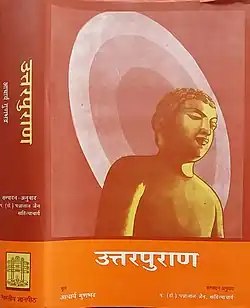Guṇabhadra (Jain monk)
Acharya Gunabhadra | |
|---|---|
 | |
| Personal life | |
| Era | 9th–10th century CE |
| Notable work(s) | Uttarapurana (co-author of the Mahapurana) |
| Religious life | |
| Religion | Jainism |
| Sect | Digambara |
| Religious career | |
| Teacher | Jinasena, Gunasena |
Disciples | |
| Part of a series on |
| Jainism |
|---|
 |
Acharya Guṇabhadra (9th–10th century CE) was a Digambar Jain monk and scholar. He is known as the co-author of the Mahapurana, a major Sanskrit epic of Jain literature. A disciple of Acharya Jinasena, He is also noted to have studied under Acharya Gunasena, one of the senior disciples of Jinasena.[1][2] he is credited with continuing and completing the Jain narrative tradition during the Rashtrakuta period.[3]
Life
Guṇabhadra was associated with the Digambar tradition and was active during the later part of the Rashtrakuta period.[4] He was a direct disciple of Acharya Jinasena, who composed the Adipurana and part of the Mahapurana. After Jinasena’s Nirvana, Gunabhadra completed the remaining portion of the epic, the Uttarapurana.[5][6]
Works
Uttarapurana
Guṇabhadra is credited with the authorship of the Uttarapurana, which constitutes the second half of the Jain Mahapurana. While his teacher Acharya Jinasena composed the Adipurana, Guṇabhadra completed the narrative with the Uttarapurāṇa, covering the lives of the remaining Tīrthaṅkaras. The text is regarded as an important source for Jain mythology, ethics, and hagiography.[7][8][9]
The combined Mahapurana (Adi + Uttara) became a model for later Jain Purāṇic literature and had a lasting impact on Jain culture in both Sanskrit and Kannada traditions.[10][11]
Legacy
Guṇabhadra is noted for his literary contributions, particularly his role in preserving Jain doctrine through narrative texts. He is credited with the authorship of the Uttarapurana, which, together with the Ādi Purāṇa, constitutes the Mahāpurāṇa, an important work in the Digambara Jain tradition.[12][13]
See also
References
- ^ Nagarajaiah 1999, p. 53-55
- ^ Upadhye 1965, pp. 35–38
- ^ Dundas, Paul. The Jains. 2nd ed., Routledge, 2002, p. 85.
- ^ Nagarajaiah 1999, p. 43-45
- ^ Upadhye 1965, pp. 40–45
- ^ Jaini, Padmanabh S. The Jaina Path of Purification. University of California Press, 1979, pp. 295–296.
- ^ Jaini 1979, p. 118
- ^ Nagarajaiah 1999, p. 55-60
- ^ Upadhye 1965, pp. 48-52
- ^ Dundas 2002, p. 27
- ^ Cort John E 2010, p. 30-32
- ^ Upadhye 1965, pp. 58-60
- ^ Nagarajaiah 1999, p. 60-62
Bibliography
- Jaini, Padmanabh S. (1979). The Jaina Path of Purification. Berkeley: University of California Press. ISBN 9780520034945. OCLC 4779344. Retrieved 20 August 2025.
- Cort, John E. (2010). Framing the Jina: Narratives of Icons and Idols in Jain History. New York: Oxford University Press. ISBN 9780195385021. OCLC 316835730. Retrieved 20 August 2025.
- Dundas, Paul (2002). The Jains (2nd ed.). London: Routledge. ISBN 0-203-39827-0. OCLC 252916273. Retrieved 7 August 2025.
- Upadhye, A. N. (1965). "Jinasena and his Literary Contributions". Jaina Sahitya aur Itihasa. Mysore: Mysore University Publications. OCLC 3115715. Retrieved 20 August 2025.
- Nagarajaiah, Hampa (1999). Jainism in Southern Karnataka. Bangalore: Sapna Book House. OCLC 45166444. Retrieved 7 August 2025.